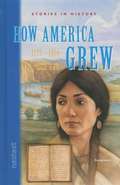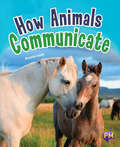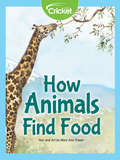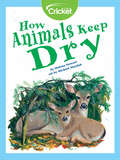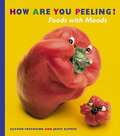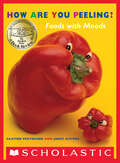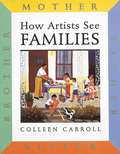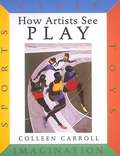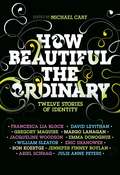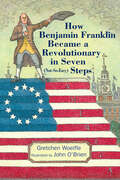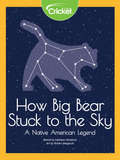- Table View
- List View
How America Grew: 1775-1914
by Nextext Staff Mcdougal-Littell StaffA collection of stories based on historical events in the history of the United States from 1775-1914, including the Lewis and Clark expedition, the Civil War, and the building of the Panama Canal.
How Angel Peterson Got His Name: And Other Outrageous Tales about Extreme Sports
by Gary PaulsenGary Paulsen's slapstick tales capture the "wonderful madness" of growing up in a small town in northern Minnesota, when high spirits, showing off for girls, and general idiocy led Gary and his pals to attempt some amazing stunts, including: <P> * Shooting a waterfall in a barrel<P> * Breaking the world speed record on skis <P> * Hang gliding with an army surplus target kite <P> * Inventing the skateboard <P> * Jumping a bike through a hoop of fire <P> * Wrestling with a bear. <P> Wacky, daring, just plain nuts -- extreme sports lead to extreme fun in these stories from Gary's boyhood.
How Animal Babies Stay Safe (Let's-Read-and-Find-Out Science 1)
by Mary Ann FraserRead and find out about how animal parents keep their babies safe from predators in this colorfully illustrated nonfiction picture book.This is a clear and appealing science book for early elementary age kids, both at home and in the classroom. It looks at the many strategies animal babies use to survive in a dangerous world. Some babies hide in nests or dens, some ride on thier parents' back or in their pouches, some use camouflage, and some rely on their parents' sharp claws and teeth to fend off enemies. Whether showing "a mother monkey swinging through the jungle with her baby on her back or two baby raccoons peeking out of their tree-house home while their mother lures a bobcat away from her young," wrote Kirkus, this book captures the eternal appeal of baby animals.It's a Level 1 Let's-Read-and-Find-Out, which means the book explores introductory concepts perfect for children in the primary grades. The 100+ titles in this leading nonfiction series are:hands-on and visualacclaimed and trustedgreat for classroomsTop 10 reasons to love LRFOs:Entertain and educate at the same timeHave appealing, child-centered topicsDevelopmentally appropriate for emerging readersFocused; answering questions instead of using survey approachEmploy engaging picture book quality illustrationsUse simple charts and graphics to improve visual literacy skillsFeature hands-on activities to engage young scientistsMeet national science education standardsWritten/illustrated by award-winning authors/illustrators & vetted by an expert in the fieldOver 130 titles in print, meeting a wide range of kids' scientific interestsBooks in this series support the Common Core Learning Standards, Next Generation Science Standards, and the Science, Technology, Engineering, and Math (STEM) standards. Let's-Read-and-Find-Out is the winner of the American Association for the Advancement of Science/Subaru Science Books & Films Prize for Outstanding Science Series.
How Animals Communicate (Into Reading, Level T #53)
by Annette SmithNIMAC-sourced textbook <p><p> Did you know that, like people, animals communicate with each other? When animals send and receive messages using smell, sight, sound, and touch, they're not just saying 'hi'—communication is vital to their survival!
How Animals Find Food
by Mary Ann FraserAnimals get their energy from the food they eat. Animals depend on other living things for food. Some animals, called herbivores, eat plants; while others are carnivores that eat other animals. Scavengers, like vultures and hyenas, eat dead animals. Learn how different animals eat and how this determines how they look and where they live. Can you name other animals that are scavengers?
How Animals Keep Dry
by Melissa StewartMany animals take cover when it rains. They like to stay warm and dry too!
How Animals Protect Themselves (Rigby Leveled Library, Level Q #62)
by Pamela RushbyNIMAC-sourced textbook
How Are You Feeling Today Baby Bear?: Exploring Big Feelings After Living in a Stormy Home
by Jane Evans Laurence JacksonBaby Bear lives in a home with the Big Bears, and loves to chase butterflies and make mud pies - they make Baby Bear's tummy fill with sunshine. Then, one night, Baby Bear hears a big storm downstairs in the house and in the morning, Baby Bear's tummy starts to feel grey and rainy. How will such a small bear cope with these big new feelings? This sensitive, charming storybook is written to help children who have lived with violence at home to begin to explore and name their feelings. Accompanied by notes for adults on how to use each page of the story to start conversations, it also features fun games and activities to help to understand and express difficult emotions. It will be a useful book for social workers, counsellors, domestic violence workers and all grown-ups working with children.
How Are You Peeling?
by Saxton Freymann Joost ElffersA wide range of emotions is presented through fruit and vegetable sculptures. Readers discover the range of expressions that a tomato or a kiwi can display, as they delight in the rhyming text that asks about their own emotions.
How Are You Peeling? (Scholastic Bookshelf)
by Saxton Freymann Joost ElffersLet Scholastic Bookshelf be your guide through the whole range of your child's experiences-laugh with them, learn with them, read with them! Eight classic, best-selling titles are available now!Category: Feelings"Amused? Confused? Frustrated? Surprised? Try these feelings on for size."This is a book that asks all the right questions. And leaves you feeling great no matter what the answers are!"Who'd have dreamed that produce could be so expressive, so charming, so lively and so funny?...Freymann and...Elffers have created sweet and feisty little beings with feelings, passions, fears and an emotional range that is, well, organic."-The New York Times Book Review
How Are You, Verity?
by Meghan Wilson DuffA neurodivergent child interacts with their neighbors to discover the true meaning behind greetings and salutations. When people say &“How are you?&” are they really asking or just saying hello? Verity, who is neurodivergent, plans an experiment to figure this out. Verity is bubbling with excitement about an upcoming school field trip to the aquarium! When neighbors ask, &“How are you?&” Verity shares their excitement and fascinating facts about sea animals. Their older brother John kindly suggests that the question "How are you?" is actually a greeting and not an invitation to share so much. Verity plans an experiment to find out if their brother is right. But when the trip to the aquarium is cancelled, Verity is heartbroken. When people ask &“How are you?&” what should they say then?
How Are You? / ¿Cómo estás? (Spanish bilingual)
by Angela DominguezFriendship awaits in this bilingual book about feelings, How Are You? / ¿Cómo estás? by Angela Dominguez-- expressed both in English and in Spanish.When two giraffe friends find a baby ostrich, they have some questions. Is baby ostrich hungry? Shy? Tired? Ostrich says no! So how does she feel?
How Artists See Animals: Mammal, Fish, Bird, Reptile
by Colleen CarrollExamines how different kinds of animals have been depicted in works of art from different time periods and places.
How Artists See FAMILIES: Mother, Father, Sister, Brother
by Colleen CarrollExamines how families have been depicted in works of art from different time periods and places.
How Artists See Play: Sports Games Toys Imagination
by Colleen CarrollExamines how sports, games, toys, and other aspects of play have been depicted in works of art from different time periods and places.
How Artists See Work: Farm, Factory, Home, Office
by Colleen CarrollExamines how people have been depicted working on farms, in factories and offices, and at home in works of art from different times and places.
How Bear Lost His Tail: Independent Reading 11 (Reading Champion #298)
by Mick GowarA fun retelling of this Native American legend. Bear is tricked by Otter into fishing with his beautiful, long tail - and it ends up getting frozen and snapping off!Reading Champion offers independent reading books for children to practise and reinforce their developing reading skills.Fantastic, original stories are accompanied by engaging artwork and a reading activity. Each book has been carefully graded so that it can be matched to a child's reading ability, encouraging reading for pleasure.The Key Stage 2 Reading Champion Books are suggested for use as follows:Independent Reading 11: start of Year 3 or age 7+Independent Reading 12: end of Year 3 or age 7+Independent Reading 13: start of Year 4 or age 8+Independent Reading 14: end of Year 4 or age 8+Independent Reading 15: start of Year 5 or age 9+Independent Reading 16: end of Year 5 or age 9+Independent Reading 17: start of Year 6 or age 10+Independent Reading 18: end of Year 6 or age 10+
How Beautiful the Ordinary: Twelve Stories of Identity
by Emma Donoghue Ron Koertge Julie Anne Peters David Levithan Francesca Lia Block Michael Cart Jennifer Finney Boylan Eric Shanower William SleaterA girl thought to be a boy steals her sister's skirt, while a boy thought to be a girl refuses to wear a cornflower blue dress. One boy's love of a soldier leads to the death of a stranger. The present takes a bittersweet journey into the past when a man revisits the summer school where he had "an accidental romance." And a forgotten mother writes a poignant letter to the teenage daughter she hasn't seen for fourteen years. Poised between the past and the future are the stories of now. In nontraditional narratives, short stories, and brief graphics, tales of anticipation and regret, eagerness and confusion present distinctively modern views of love, sexuality, and gender identification. Together, they reflect the vibrant possibilities available for young people learning to love others--and themselves--in today's multifaceted and quickly changing world.
How Beetle got its Colourful Coat: Independent Reading Orange 6 (Reading Champion #1076)
by Sarah SnashallThis story is part of Reading Champion, a series carefully linked to book bands to encourage independent reading skills, developed with Dr Sue Bodman and Glen Franklin of UCL Institute of Education (IOE)Reading Champion offers independent reading books for children to practise and reinforce their developing reading skills.Fantastic, original stories are accompanied by engaging artwork and a reading activity. Each book has been carefully graded so that it can be matched to a child's reading ability, encouraging reading for pleasure. Perfect for 5-7 year olds or those reading book band orange.
How Ben Franklin Stole the Lightning
by Rosalyn SchanzerBen Franklin was the most famous American in the entire world during colonial times. No wonder! After all, the man could do just about anything. Why, he was an author and an athlete and a patriot and a scientist and an inventor to boot. He even found a way to steal the lightning right out of the sky.<P><P> Is such a thing possible? Is it. Take a look inside and find Ben busy at work on every spread. Then find out how he used his discovery about lightning to make people's lives safer.<P> In an inventive way, Rosalyn Schanzer brings us a brilliant and ever-curious American original.
How Benjamin Franklin Became a Revolutionary in Seven (Not-So-Easy) Steps
by Gretchen WoelfleHow did Ben Franklin become an outspoken leader of the American Revolution? Learn all about it in seven (not-so-easy) steps in this humorous, accessible middle-grade chapter book that focuses on Ben&’s political awakening.Famous founding father Benjamin Franklin was a proud subject of the British Empire—until he wasn&’t. It took nearly seventy years and seven not-so-easy steps to turn Benjamin Franklin from a loyal British subject to a British traitor—and a fired-up American revolutionary. In this light, whimsical narrative, young readers learn how Franklin came to be a rebel, beginning with his childhood lesson in street smarts when he buys a whistle at an inflated price. Franklin is a defiant boy who runs away from his apprenticeship, and while he becomes a deep thinker, a brilliant scientist, and a persuasive writer when he grows up, he never loses that spark. As a community leader who tries his best to promote peace and unity both between the colonies and with Great Britain, he becomes more and more convinced that independence for the American colonies is the way forward.Illustrated throughout with art by noted New Yorker cartoonist and illustrator John O&’Brien and sprinkled with quotations from Franklin, this unfamiliar story of a familiar figure in American history will surprise and delight young readers.
How Bicycles Changed the World / Young Bike Racers (Fountas & Pinnell Classroom, Guided Reading Grade 4)
by Michael SandlerNIMAC-sourced textbook
How Big Bear Stuck to the Sky
by Kathleen MuldoonOne of the most well-known constellations in the night sky, the Big Dipper, traces its origins to a Native American legend. Many animals attempted to break through Sky in order to spread light and warmth onto the Earth. Only one of them, a Great Bear—also known as Ursa Major—succeeds. How does Great Spirit reward him?
How Big Could Your Pumpkin Grow?
by Wendell MinorEvery year, giant pumpkin contests take place at fairs across the country—the 2012 record-holder weighed over a ton! The latest craze is to carve the most enormous pumpkins into racing boats. But what&’s next? Why not think really big? Award-winning artist Wendell Minor does just that as he imagines larger-than-life pumpkins decorating some of America&’s favorite places—as immense as the Capitol dome, Mount Rushmore, the Brooklyn Bridge, even the Grand Canyon! This celebration of famous landmarks and landscapes plays with concepts of size and scale and is full of fun facts.
